Regulating The Flow Of Gases
The valves regulate the flow of gases into and out of the combustion chamber. Their main operation is to open and close the ports (gas inlets and outlets) when required. To do this, they must make a completely gas-tight seal in the ports when these are closed, while offering no opposition to the flow of gases when the ports are open. They must also operate with the least friction possible, and this means they should have the simplest possible mechanism to operate them. The four-stroke
engine has been in production for nearly a century, and in that time the poppet valve and its mechanical operation have evolved as being the best all-round system.
The only serious contender was the sleeve-valve arrangement, used on cars until the mid-1930s. Its main advantage was its silent operation and freedom from wear. It was superseded by the poppet valve system due to the sleeve-valve system's heavy oil consumption and high initial cost. Four main types of valve have been developed for use in the
internal combustion engine, the other two being the slide valve and the rotary valve - both of which are now completely obsolete.
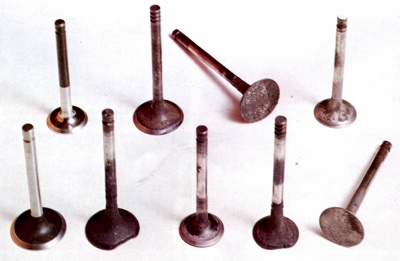
A selection of poppet valves showing various degrees of wear. The exhaust valves wear more as they are subjected to very high temperatures. In extreme cases, the valve may actually burn away.

Valve assembly showing poppet valve with return spring, retainer and securing split collet.
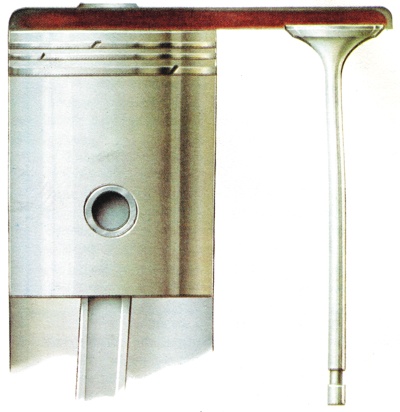
Side Valve or L-Head. The design became obsolete during the 1950s due to its low efficiency and restricted compression ratio.

The T-Head, another side valve design, had an even shorter career than the L-Head above. As shown, the T-Head had the inlet and exhaust valves on opposite sides of the cylinder.
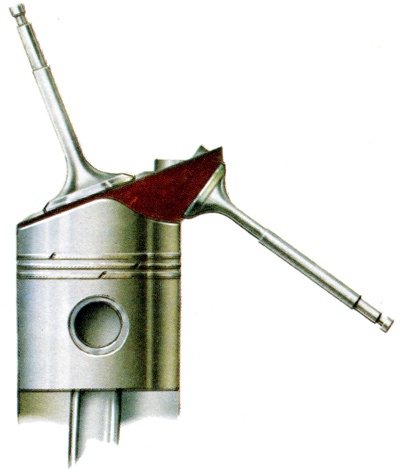
The F-Head lost favour in the 1970s. It lasted longer than the L-Head and T-Head because it had an overhead inlet valve , however it still had the drawback of a side exhaust valve.
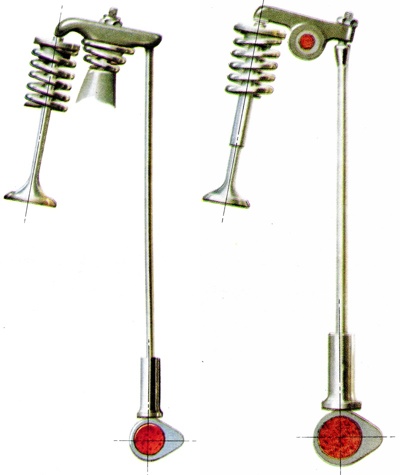
Shown left is a OHV valve train with cam, cam follower, push-rod and individual ball-mounted rocker boats. On the right is an OHV valve train with the valves being operated by the more common method of a shaft located rocker.
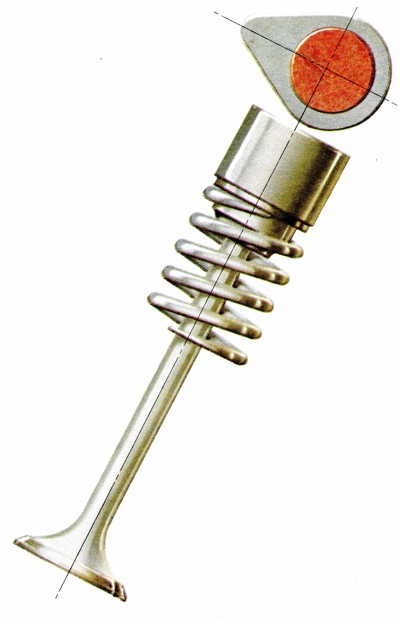
Overhead cam-valve operation with the cams operating directly on the valve buckets.
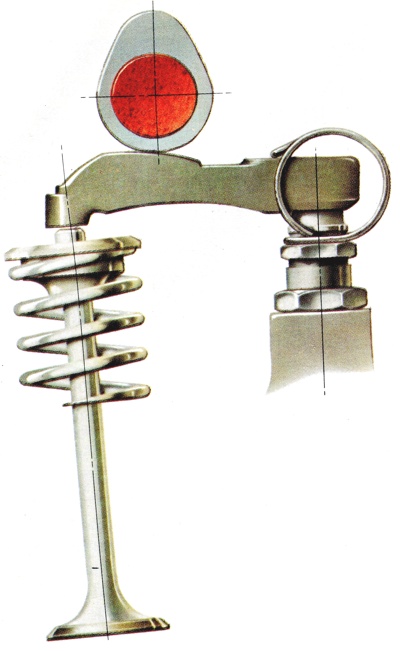
On some designs with overhead camshafts the cams do not bear directly on the valves but through finger-type half-rockers. |
Poppet Valves
The universally-used poppet valve is mushroom shaped, with a long stem. At one end is the head, which forms a gas-tight seal against its seating in the
cylinder head. At the other end is a groove which is used to locate the securing collets. Poppet valves are made from steel. The exhaust valves have manganese, silicon, nickel and chromium additives to enable them to withstand the higher temperatures to which they are subjected.
These temperatures can be as high as 650C when the
engine is running at high speed, which can cause the valves to become red hot. The inlet valves are not subjected to the flame of the exhaust gases passing them, and are also cooled to an extent by the charge of petrol/air mix sweeping over their heads during the induction stroke. After a period of use, the heads of the inlet valves usually have a black appearance, while the exhaust valves are a whitish-grey colour.
An inlet valve is usually larger in diameter than its exhaust counterpart because the induction of the combustion mixture is slightly less forceful than the rapid outflow of the exhaust stroke gases. The faces of the valves are ground at an angle to match their seatings - usually 45, but sometimes 30.
The wedge action resulting from this grinding helps ensure a better seal than would be the case of a flat fitting valve and seating. The valve seating is usually narrower than the mating face of the valve, reducing the chances of carbon particles becoming trapped between the valve and its seating. This also offers a slight overlap to guarantee a perfect seal.
The valve face, in addition to being slightly wider than its seating, also has an extra thickness above the angled part. This is arranged to eliminate any chance of a 'sharp' edge forming round the seating, which would become excessively hot (especially in the case of the exhaust valve), resulting in possible pre-ignition and premature failure caused by breakage at the perimeter of the head.
In the case of the heavily-stressed exhaust valve, the angle between the valve-head and its seating may be over-ground by half-a-degree or even less. This gap allows for expansion of the valve under optimum operating conditions. It also takes into account the possibility of the head 'dishing' very slightly at extreme
engine speeds when the combination of heat and the hammering effect reaches a peak.
Before mass production techniques were used, each valve was hand-mated to its seating with grinding paste to ensure that the valve-head fitted perfectly. With mass-produced parts, it has been found that the valve movement due to spring operation causes a form of self-seating to occur.
Under correct operation, these sealing properties can last for as long as 160,000 km (100,000 miles) or more. Heat dispersal is a major problem, especially with the exhaust valves. Some heat is lost through the stem, where it is absorbed through the valve gear in the
cylinder head, while another loss takes place through the valve seating into the
cylinder head direct.
In highly specialized
engines, the exhaust valve has a hollow stem partially filled with sodium, which has a melting point of 98 C. At running temperatures, the sodium melts and splashes between the ends of the valve to dissipate the heat. But this is an expensive arrangement and is reserved for competition or test
engines where cost is not a major consideration. Valve seatings are pressed into the
cylinder head to become an integral part of the head. The seating is harder than the valve itself because it is rather easier to renew a worn valve than it is to renew the valve seating.
Wear at the valve seating and valve can result from a number of factors. If the valve clearances are incorrectly adjusted and the valve does not fully close, the flame will find its way past the exhaust valve and burn the perimeter fairly quickly. This will result in the valve becoming charred, its sealing properties will be marred, and the rate of wear will increase rapidly until the point is reached where the cylinder is not sealed and the power output from that cylinder falls drastically.
The seating can also become severely damaged and, if the wear process is allowed to continue, it is possible for the combustion chamber itself to become damaged. An excessively weak, or lean, mixture caused by an air leak or by incorrect carburettor adjustment can result in a 'dry' flame during the combustion process, which will also tend to cause valve burning.
Worn valve guides or ruptured seals on the valve-stems may allow oil to dribble down the guides and gradually build up carbon deposits at the end of the stem, thus affecting the sealing properties and eventually resulting in burning of one form or another. A light degree of burning, or pitting, can be overcome by carefully grinding-in the valve and its seating. More advanced damage to the seating can be overcome by re-cutting the angle and fitting a replacement valve.
It is also possible to fit replacement seats in some cases. None of these defects is likely to arise in the normal course of events and valve defects are invariably the result of age, neglect of routine maintenance and, rarely, bad luck. Early warning of valve failure is invariably apparent in the shape of misfiring at high speeds. Confirmation of valve wear or failure can be easily obtained by a compression test on each cylinder. Worn valves are a major source of low compression.
Valve Positions
The positions of the valves depend on the design of the
engine combustion chamber. There are five possible positions:
- Side valve, L-head. This has both valves at one side of the cylinder, heads uppermost, with their stems approximately parallel to the axis of the cylinder. To accommodate the valves in this position, the combustion chamber is extended sideways from the top of the cylinder forming a shape similar to an upside down letter 'L'. Though popular at one time, this design is now obsolete due to its low efficiency and restricted compression ratio (about 7:1).
- Side valve, T-head. This is similar to the L-head, except that the inlet and exhaust valves are fitted at opposite sides of the cylinder.
- Vertical overhead valve. This design has both valves fitted over the top of the cylinder with their stems nearly vertical and parallel to each other, usually in a single row.
- Overhead inlet and side exhaust, or F-head. This design has the inlet valve in the same position as (3), that is, vertically overhead. The exhaust valve is in the same position as in (1), that is, on the side of the cylinder.
- Inclined overhead valve. In this design, both valves are fitted over the top of the cylinder head, but in two rows inclined at an angle to each other.
Valve Operation
The valves are moved to, and held in, their closed positions by their springs. They are opened by cams (pear-shaped discs) which are carried on one or more camshafts. These are driven by a chain, belt, or gearing from the crankshaft. The cams do not usually act directly upon the valves to operate them, since their rotary movement would put a side force upon the valve stem. To prevent this side force, cam followers are placed between the cams and valves. These cam followers are:
- Tappets, which rest upon the cams and are guided to move in a straight line. These take the form of a hard metal cup.
- Rockers or levers, which rock upon fixed pivots.
The diameter of the cam follower is at least the same as the width of the cam, and sometimes greater. This is to spread the rubbing-surface load. There is a basic gap between the base of the cam follower and the cam itself to ensure that the valve can close fully, and also to allow some lubrication between the cam and cam follower from the oil mist that is present in the camshaft area. The load spreading is also aided by the cam follower being slightly offset in relation to the cam, or by the cam itself being ground slightly off-centre. The F-head, discontinued in the 1970s, even with its overhead inlet valve still had the drawback of a side exhaust valve.
If the cams are placed close to the ends of the valves, no additional mechanism may be needed, but in so-called overhead valve engines this is obviously impossible. In many engines, it is considered preferable to place the camshaft reasonably near the crankcase, to enable a short and simple driving gear to be used. In such cases the motion of the
tappets is transferred to the valves through push rods and overhead rockers.
In overhead camshaft engines, the camshaft is sited over the top of the
cylinder head. This means that, with the valves functioning inside the combustion chambers, the entry and exit of the gases involved during the engine's cycle is aided. Greater efficiency results from this, combined with the more-or-less direct action occurring on the valves.
Valve Rockers
In some overhead-cam designs, the cams bear directly on to the valves. In others, the effort is applied through rockers, for example in push-rod overhead-valve engines. Direct application is the ideal situation from an efficiency point of view, but layout complications often result in a compromise, and the rocker is usually the compromise. With the push-rod overhead-valve
engine, the movements of the cams on the camshaft are transmitted to the
cylinder head through slender rods made from solid steel, or tubes made from steel or light alloy with pressed-on hardened ends.
The lower end of the rod is usually rounded to fit into the matching hollow in the cam follower. The top end is usually cupped to receive a ball-ended adjuster in the rocker arm. Oil is fed through the rocker to provide a form of oil cushion between the top of the push rod and the adjuster point. This slows down the rate of wear and gives a silencing effect. The oil then falls down the push rod housing to help lubricate the cam follower area.
In-line engines have their rockers supported in the middle of the
cylinder head, either on a rocker shaft running the length of the
cylinder head, or less commonly on individual ball mountings. In either case, the principle is the same, the push rod forcing one end of the rocker upwards so that the other end pushes downwards to open the valve. The rockers are mounted on a rocker-shaft, and are either steel forgings or steel pressings. They are pressure-lubricated from a drilling in the shaft and are equipped with replaceable bushes, often of a honeycomb pattern, to allow an adequate supply of oil between the rocker and shaft.
A drilling through the rocker itself carries oil to the push-rod end and the surplus oil falls, by gravity, back to the engine's sump through the camshaft area or through the timing case to lubricate the timing chain. The oil mist in the rocker-box offers a degree of lubrication to the valve stems and, to an extent, between the valve stem top and its matching rocker-pad.
The rocker-pad, on the valve side of the rocker, is usually curved slightly as it has a slight rubbing effect as it presses down on the valve stem, and is case-hardened to resist the hammering effect involved in valve operation. To ensure that the gap needed between the cam follower and cam is correctly maintained, the distance between the rocker-pad and valve stem, with the valve fully closed, is used.
Although the rockers are a sliding fit on the rocker-shaft, a tendency for them to move along the shaft is checked by the use of spacers or light springs or both. Those push-rod engines with no rocker shaft have their rockers in the form of 'boats' mounted on a ball sited on top of a short support. The action is the same as in the more common rocker-shaft arrangement, but the slightly more complicated rocker shaft is dispensed with and lubrication relies on oil mist in the rocker box. Clearances are effected through a nut in the middle of the rocker.
Drive Types
The push-rod
engine is, theoretically, a fairly crude design because of the complicated linkage between the camshaft and the valves, which includes a comparatively large number of wear-points. At one time, the push-rods were susceptible to 'bowing' after a period but this tendency has been, for all practical purposes, eliminated by the decrease in push-rod length arising from short-stroke engines.
Wear is remarkably low and the mechanical efficiency of the system is high. It is likely that the push-rod
engine evolved from the old side-valve unit when it became possible to use the same camshaft and cylinder block arrangement in the more efficient overhead-valve layout.
There can be little doubt that the single OHC arrangement is more efficient and cheaper to make, but it is only when a completely new
engine, which does not rely on any components from previous designs, is introduced that the overhead-camshaft takes over from the push-rod pattern. With single OHC engines, the camshaft may operate either directly on the valves or. less directly, through half-rockers of the finger type, or it may operate two rows of rockers. The trend is towards the first arrangement, which has the merit of simplicity and cheapness of construction.
Valve Guides
In any form of valve-train drive, a degree of side thrust is unavoidable - even when the valves are vertically mounted in the
cylinder head with the cams bearing directly on them. In this case, the single OHC layout, the rotary movement of the cam changes to a reciprocating direction as the valve moves up and down. With the rocker arrangement, the rocker-pad is moving in an arc and, in both cases, there is inevitably a rubbing action with an associated amount of side thrust on the valve stem.
To counteract this effect, the valve is held as rigidly as possible in a guide. The guide was once, universally, a separate cast-iron cylinder pressed into the
cylinder head so that its end did not protrude into the combustion chamber. Some guides had a flange incorporated which butted against the
cylinder head top while others were of a plain design pressed into place to a carefully predetermined limit.
The valve is a close fit inside the guide and the part of the stem protruding above the guide in the rocker box is lubricated by the oil mist present. To prevent oil finding its way down between the valve stem and guide, oil seals are fitted on the valve stem. The seals may take the form of tight fitting synthetic-rubber rings or shrouds. There is a tendency to move away from the separate valve-guide to a hole drilled in the head in which the valves fit. This system trims the cost of
engine construction.
Valve Guide Wear
Some wear is inevitable, no matter which type of arrangement is adopted, and the valve stem tends to become a progressively looser fit in its guide. An air leak is the result of wear as far as the inlet valves are concerned and this will affect the carburetion balance of the
engine. Such an air leak cannot be 'tuned-out' by adjustment at the carburettor. There is also the probability of oil finding its way into the combustion chambers, with consequent fouling of the spark-plug points and valves, in addition to a build-up of carbon in the combustion chambers themselves.
With separate valve guides, the cure is the fitting of new valves and guides. When the alternative arrangement is used, the valve guides have to be drilled out to a predetermined oversize diameter and appropriate valves fitted. Oil contamination is also inevitable if the oil seals rupture. The valve train arrangements on all four-stroke reciprocating engines end at the valve springs, whose main function is to close the valves fully and hold them closed during the appropriate periods of the operating cycle. The retention of the closed period is assisted by the action of the
piston, but it is the spring that is essential.
Valve Springs
Spring design has to balance the weight of the valve-operating mechanism to return all the components involved to a fully at-rest position for the next sequence of the cycle. The energy needed to accomplish the reverse effect of the positive opening drive is less than the energy needed to open the valve because the valve drive gear is not under pressure but it is, nevertheless, essential that the status-quo of the valve train is restored instantly.
The coil spring layout for valve closing is virtually universal because of its compact shape. A more efficient arrangement is the hairpin spring but this layout demands a considerable amount of space and is found only on highly specialized engines.
Valve springs are fitted under compression and are held in place with one end resting on the
cylinder head. The other is usually retained by a circular plate covering the diameter of the spring at its top. In the valve stem is a groove into which fit a pair of tapered steel collets to lock the plate and, therefore, the spring. The compression of the spring holds the collets firmly in place and they can be removed only when the spring tension is relieved.
Alternatives to the split collets include a disc with a slot cut in it and a retaining plate with a figure-of-eight elongated hole whose smaller half locks the spring in place and larger half allows the plate to be slid to one side to clear the valve stem for spring removal.
A disadvantage of any type of spring is its tendency to return to its at-rest position through a period of over-reaction. The principle is most easily illustrated by wedging a steel ruler at one end and flicking the other end downwards. For a short time, the ruler will vibrate up and down before coming to rest and exactly the same happens in the car's suspension system if a shock-absorber fails when the car will bounce up and down a number of times.
With the valve spring, this bouncing effect can literally result in the valve, especially at high speeds, bouncing on its seating and completely upsetting the engine's power output. It is also possible for the spring to break under conditions of excessive bounce with the remote possibility of the valve falling inside the cylinder. To overcome the perils of bouncing, coil springs may be wound so that their adjacent coils almost touch when the valve is fully opened. If bounce does occur, the touching of the coils will 'kill' the bouncing tendency with only a fleeting loss of power from the
engine. Another solution to the problem is to wind the spring in a progressive fashion, with the coils nearer the
cylinder head being closer than those at the top of the valve stem.
This breaks up the spring's bounce period. Yet another arrangement is to fit double or even triple springs one inside the other. The : differing rates of surge in the springs will help to cancel out : any tendency for surge to build up to the point of valve bounce. The life of valve springs is impossible to determine and r there are many cases of the original springs giving excellent service for 160,000 km and more. It is always possible for a valve spring to break and such a condition will usually . make itself felt in the form of misfiring. With double-springs, it is even less likely for breakage to occur but it is not always so easy to see such a defect when the inner spring breaks.
A compression test of each cylinder may reveal a defective spring, but a much more definite method is to use an electronic
engine-analysis machine or, for the home mechanic, a vacuum gauge. The low cost of springs makes it worthwhile renewing the entire set when the
cylinder head is removed for a top overhaul and it may be worthwhile checking to see if d stronger springs are approved by the car's makers to offer e higher engine speeds.



